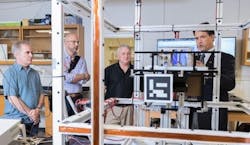Laser-based system with a single transmit/receive aperture could expand space-to-ground communication
A collaboration between the Georgia Institute of Technology (Atlanta, GA) and satellite communications provider Xenesis (Chicago, IL) could help open the bottleneck that now limits the flow of data from Earth-orbiting satellites to ground stations.
The project will miniaturize, space-qualify, and test a laser-communications transceiver that could dramatically expand the bandwidth available for downlinking information from the growing number of satellites—and future constellations of space vehicles—in low Earth orbit.
Xenesis has licensed the technology from NASA's Jet Propulsion Laboratory (JPL; Pasadena, CA), and will work with Georgia Tech and JPL to mature it for use as a primary communication system for satellites as small as CubeSats.
JPL's transceiver contains an optics module with a 5-cm-diameter telescope and an electronics/laser module emitting in the C band (1530 to 1560 nm). The received uplink is at a wavelength of 1568 nm. Data rate is up to 10 Gbit/s over four 2.4 Gbit/s channels.
Brian Gunter's lab at Georgia Tech has experience with small satellites, and will apply that expertise to the project with Xenesis, which signed a $1.2 million contract on June 14 to support the work. Georgia Tech's contribution will be to miniaturize the original JPL technology, update the control software, space qualify all the hardware, and test the improved system from space, likely from the International Space Station.
"Most of today's systems depend on radio-frequency downlinks, and there is just a limited amount of bandwidth available for use," says Dennis Poulos, chief technology officer at Xenesis.
Laser-based systems can expand that bandwidth to beyond 10 Gbit/s, Poulos says. In addition to boosting bandwidth, optical systems can use smaller antennas, use power more efficiently, and provide better data security.
Though it is subject to interference from clouds, the laser system will benefit from producing a narrow beam that can travel farther than comparable radio-frequency transmissions at the same power level.
The initial focus will be space-to-ground communication, though the system could also be used for cross-linking communication between satellites. The small antenna size is also more suitable to the small-form satellites envisioned for future constellations that may include thousands of spacecraft.
Sources:
1. http://www.news.gatech.edu/2018/06/25/laser-based-system-could-expand-space-ground-communication
2. http://xenesis.io/wp-content/uploads/2018/05/Xenesis-Branded-Laser-Transciever.pdf

John Wallace | Senior Technical Editor (1998-2022)
John Wallace was with Laser Focus World for nearly 25 years, retiring in late June 2022. He obtained a bachelor's degree in mechanical engineering and physics at Rutgers University and a master's in optical engineering at the University of Rochester. Before becoming an editor, John worked as an engineer at RCA, Exxon, Eastman Kodak, and GCA Corporation.
